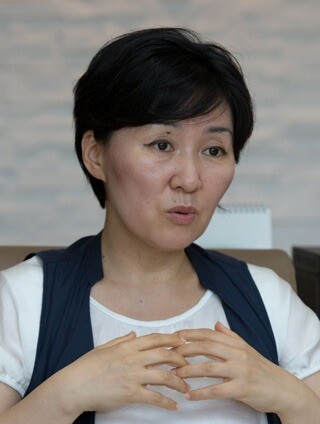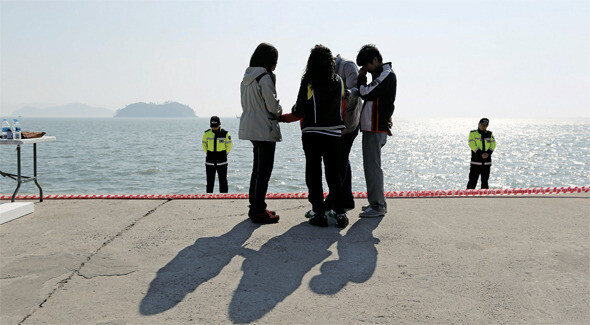hankyoreh
Links to other country sites 다른 나라 사이트 링크
[Interview] PTSD in the fallout of the Sewol sinking

By Kim Yang-joong, medical correspondent
“The scene of the ship sinking into the ocean with the children aboard was broadcast live, as if in slow motion. But we could do nothing, and ultimately we did nothing. Even though a deadly germ penetrates the skin and spreads to the organs, causing inflammation, it can be treated with antibiotics as long as it remains local. But when that germ enters the bloodstream, it causes blood poisoning, and the majority of patients die. The tragedy of the Sewol was not a local infection; the germs were already in the bloodstream,” the doctor said.
Psychiatrist Jeong Hye-shin said that the sinking of the Sewol had inflicted such a severe shock on Korean society as a whole that it could lead to “psychological death.” In the past, Jeong treated workers laid off by Ssangyong Motor for post-traumatic stress disorder (PTSD).
In an interview printed in the Apr. 28 issue of the Hankyoreh 21 magazine, Jeong said, “If the Korean people are unable to cope with the national trauma caused by the sinking, it could leave a scar on society similar to that caused by the Korean War.” Jeong believes that an unprecedented number of people would need psychological treatment.
Jeong’s explanation for why the friends and family of those who died or are missing were not the only ones traumatized was that there was not a single Korean adult who was not complicit in the flawed social order that paralyzed the systems supposed to save lives. According to Jeong’s diagnosis, the irresponsibility and the incompetence in the response to the accident were what prevented the entire public from avoiding the guilt and sense of responsibility that are the central emotions in trauma. “If the ship sinking was the first trauma, the government’s inept response was the second,” Jeong said. “Ultimately, it was the second trauma that broke us.”
Jeong argues that someone must absorb the rage resulting from the tragedy of the Sewol in order for people to rein in their emotions. Jeong emphasized that the one and the first and last person who can deal with this disaster is the president.
“Currently, not only the victims of the tragedy but all of us are feeling a mix of various emotions, which we have been unable to process. Of these emotions, the one that can be dealt with first of all is rage. To do that, someone in a position of responsibility needs to really take responsibility. Until that happens, there can be no progress with people’s emotions or in the overall situation,” Jeong said.
“The president has to apologize first and take responsibility. But it appears that the president is the only one who doesn‘t feel guilty. Even worse, she is getting angry and scolding people. She seems like someone from another country, who lacks the emotional link to connect her to the pain right now. If the president does not put herself in a position where she can absorb these emotions, the entire public will continue to feel as if they are being stabbed with a knife,” Jeong went on to say.
Jeong is concerned that if the survivors and the bereaved families - who have the worst cases of PTSD - do not receive the proper treatment, they could make an extreme decision even several years down the road. The psychiatrist recommended that, in order to prevent this from happening, government money should be used to set up a PTSD treatment center in Ansan and provide the victims with thorough treatment.
“The survivors and the bereaved families need at least two to three years of constant treatment and care. In this case, not only are there a lot of people who need healing, but finding an accurate and concrete solution for the trauma will require creating a system for social healing. We will need to keep working on this for ten years at least,” Jeong said.
“For the survivors, the first symptoms of post-traumatic stress disorder are trouble sleeping, loss of appetite, and constantly being reminded of the loved ones who are gone and the moment when they found out that they had died. And as time goes by, some of the survivors and bereaved families start to absorb themselves in their work or something else in order to forget those memories. There are some children who focus entirely on their studies to avoid thinking about anything else,” Jeong said. According to the psychiatrist, the second phase of PTSD involves diligently concentrating on some activity. By becoming absorbed in something unrelated to their traumatic experience, patients are trying to forget their uncertainty, pain, and guilt.
“When their friends and family see the survivors absorbed in something, they take this as evidence that they have gotten over their pain. Of course, the survivors may think the same thing. But this is an illusion. This kind of obsessive concentration can be interrupted at any moment for very trivial reasons. This is why we have to make a treatment system that takes a long-term, comprehensive view of PTSD,” Jeong said.

How can we heal the emotional scars of the people who watched and suffered this accident alongside the survivors? “The mothers who came to look at their dead children’s faces said that the children‘s bodies were cold and asked for blankets. They didn’t realize that the bodies were cold because there was dry ice beneath them. The dry ice is necessary to keep the bodies from rotting, but it occurred to me that covering the children’s bodies with a warm blanket would be a good way to console the mothers. I think that we should adopt a similar method when dealing with the emotional trauma caused by the Sewol,” Jeong said.
More specifically, Jeong suggested visiting the memorial altars that have been set up all around the country. Jeong explained that having someone to share their sorrow can make people feel less sad, and that one of the reasons why people are having such a hard time is because they are mourning by themselves. Jeong went to Jindo, the location of the families of the victims and the missing in the Sewol accident, on Apr. 24.
Please direct questions or comments to [english@hani.co.kr]

Editorial・opinion
![[Column] Park Geun-hye déjà vu in Yoon Suk-yeol [Column] Park Geun-hye déjà vu in Yoon Suk-yeol](https://flexible.img.hani.co.kr/flexible/normal/500/300/imgdb/original/2024/0424/651713945113788.jpg) [Column] Park Geun-hye déjà vu in Yoon Suk-yeol
[Column] Park Geun-hye déjà vu in Yoon Suk-yeol![[Editorial] New weight of N. Korea’s nuclear threats makes dialogue all the more urgent [Editorial] New weight of N. Korea’s nuclear threats makes dialogue all the more urgent](https://flexible.img.hani.co.kr/flexible/normal/500/300/imgdb/original/2024/0424/7317139454662664.jpg) [Editorial] New weight of N. Korea’s nuclear threats makes dialogue all the more urgent
[Editorial] New weight of N. Korea’s nuclear threats makes dialogue all the more urgent- [Guest essay] The real reason Korea’s new right wants to dub Rhee a founding father
- [Column] ‘Choson’: Is it time we start referring to N. Korea in its own terms?
- [Editorial] Japan’s rewriting of history with Korea has gone too far
- [Column] The president’s questionable capacity for dialogue
- [Column] Are chaebol firms just pizza pies for families to divvy up as they please?
- [Column] Has Korea, too, crossed the Rubicon on China?
- [Correspondent’s column] In Japan’s alliance with US, echoes of its past alliances with UK
- [Editorial] Does Yoon think the Korean public is wrong?
Most viewed articles
- 1‘We must say no’: Seoul defense chief on Korean, USFK involvement in hypothetical Taiwan crisis
- 2[Reportage] On US campuses, student risk arrest as they call for divestment from Israel
- 3[Column] Park Geun-hye déjà vu in Yoon Suk-yeol
- 4‘Weddingflation’ breaks the bank for Korean couples-to-be
- 5Korea sees more deaths than births for 52nd consecutive month in February
- 6N. Korean delegation’s trip to Iran shows how Pyongyang is leveraging ties with Moscow
- 7Amnesty notes ‘erosion’ of freedom of expression in Korea in annual human rights report
- 8Will NewJeans end up collateral damage in internal feud at K-pop juggernaut Hybe?
- 9N. Korean hackers breached 10 defense contractors in South for months, police say
- 10[Guest essay] The real reason Korea’s new right wants to dub Rhee a founding father